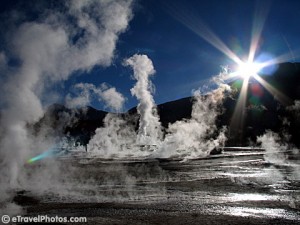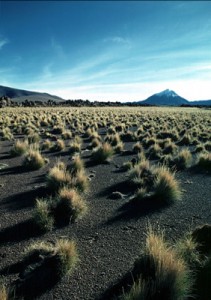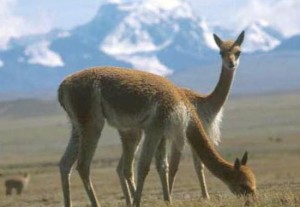I would say 3:40 dawned bright and early, but dawn comes LONG after 3:40. I did manage to roll out of bed, despite my track record, at the first sound of my alarm. I got my 85 layers of clothing on, as recommended by the guide book, the tour vendor, and other travellers, and headed downstairs. The lights were off in the reception area, which meant no one to return my key to. The receptionist had assured me that the tour departed from our hostel, but there wasn`t another soul in sight. I chose to go stand outside in the street (just a dirt path, really). 4:08 and still no one. Finally, a young woman walked out the front gate. I threw out the standard “Hablas inglès?” To which she replied “Yes, please!” Her name was Mamika, from Japan and attending school in Australia. Sure enough, five minutes into our conversation, the van driver showed up.
After 15 minutes of driving from hostel to hostel, we headed off for El Tatio, the world`s highest geyser field.
The reason the tour starts in the middle of the night is to allow us to reach the geysers by dawn when the temperature difference at 14,000 feet is the most extreme. It took over 70 miles of nothing but dirt roads, some of the roughest I`ve ever been on, to get there. You`d never find your way without a guide service. The van was full of individual straight backed seats, which had every passenger contorting her/himself into all kinds of odd positions in the name of comfort. Despite the seats, it was the best vehicle I`ve been in so far combined with the best driver I`ve had. Except for the parking brake, which seems not to work in ANY of the vehicles down here, the van was in great shape. The driver was a native from one of the villages near the geyser field and was the first person I`ve seen even consider caution while behind the wheel. And he still managed to do an excellent job of getting us safely around the slower tour vans.
When we arrived at the geysers, the guide gave us an introduction which included the fact that El Tatio means “the old man that cries” in one of the native languages, and the giant hunk of machinery plunked down in the middle of the whole thing was to supply the world`s largest copper mine (100 miles away) with electricity. Wow. El Tatio was definitely NOT what I was expecting. First of all, there are almost zero conservation measures in affect. We drove right over the top of several fumaroles and small geysers! We also drove through the rivers created by the run-off. The fifty or so crossings per day have to be wreaking havoc as far as erosion is concerned. No official bathroom means the field of rocks above the field are actually a toxic waste hazard waiting to happen. Inadequate signage leaves tourists highly uninformed and therefore in danger if they don`t know about the behavior of geysers. No boardwalk through and among the geysers means visitor can walk where ever their feet will carry them, a problem for several reasons.
1) The ground among and around geysers is always hollow. In many places, the crust separating you from the boiling water below is inches thick (i.e. not thick enough to hold the weight of your average tourist). Most people that visit have no idea that the “neat hollow sound” you hear when you walk is actually a threat to your life. Several people have died here. One geyser is even named “El Frances” for the three French tourists that fell through the crust and boiled to death a few years ago.
2) Ecosystems around geysers and hotpools are really fragile. The bacteria that grows needs a very specific environment in which to thrive. That`s why you see the different colors in pools; each color is a different type of bacteria that thrives at a different temperature. Having hundreds of feet tramping through it daily pretty much wipes it out. People also toss in their lucky pennies and cigarette butts, which changes the chemistry of the water and kills the bacteria. Guide services use the hot pools to warm the milk for our morning coffee!
3) People don`t know how hot the water of a geyser is nor how unpredictable eruptions are, both in frequency, duration, and intensity. As a result, people climb up the cones of a freshly erupted geyser to have a look inside, and stand as close as possible during eruptions so as to procure a little heat in light of the freezing morning temps. (Genius! What are you going to do when the geyser stops putting out heat and you`re now 50% wetter than before?) Countless tourists have been scalded.
Mamika and I descended carefully across the field walking from geyser to geyser. She was environmental management major in school, and so was interested in everything I could tell her about geysers. I naturally walk pretty quickly due to growing up with a long-legged father, so Mamika took the responsibility of keeping our pace in check. At that altitude, you have to arrest your steps to an alarmingly slow stroll or else! Anything faster makes you want to vomit and/or gives you a violent headache (I found out later). With everyone walking so slow, I felt like an extra on the set of some zombie horror film. Weird.
After we visited the first of two fields, we went to the second where vistors could soak in some hot springs. I opted out because I would have to haul my wet clothing and towel around with me for the rest of the day as I travelled on to Iquique. Instead I opted to go for a walk off towards the mountains hoping to bump into some of the animals that inhabit the desolate high plain. I found more used toilet paper than anything else, and saw one lizard. Also, I saw a cactus with spines so dense that I mistook it for grass. The neatest part of my solo venture, however, was the grass mounds. There were little tufts of grass every few feet in all directions (see photo) that looked like some green thumb planted a grass bomb underneath the soil and it had exploded. Apparently animals had been grazing in the area, because almost every tuft had a sort of buzz cut gone wrong. Stepping on the tufts felt like standing on a wire brush. It was awesome!
On the way back to San Pedro from the geysers, I got my wish concerning animals. We saw a ton of wildlife and some awesome flora. First across our path was a small herd of vicuñas, a relative of the llama. See photo. It looks like a cross between an antelope and llama. A few minutes later, the road came within a stone’s throw of a desert marsh where these giant sage chickens were hanging out. They had bodies the size of basketballs, red heads, white necks and heads, and black everything else. I couldn’t believe their size! Finally we passed a bunch of domesticated llamas in a canyon. Instead of branding, the llama rachers tie all different colors of ribbons through the ears and around the necks of their animals. It’s really neat; they look so festive!
We stopped in a the only small village near the road on the way back to town to look at the 400 year old church and buy sopapillas or empenadas, if we so chose. I had a delicious sopapilla. Actually, make that two. I couldn’t help it! The buildings in the village were really neat to see. The walls were constructed of stones cemented together with mud, and the roofs were thatched grass from the limitless exploding tufts.
The last stretch back to town was full of rockish canyons of reddish brown stone. It reminded me of the rocks alongside interstate just outside Douglas, but reddish brown instead and tons more. Whole fields of them! It was like being on the moon or something.
I realized in the van on the way back that I’m really lucky to have English as my first language, but it’s also a disadvantage. The debatably postive side is that English is the second language of the world. Almost all the travellers I meet speak their native language, English, and limited Spanish. As a result, if you’re from any non-English speaking country, you’ve got to learn the language of the place you’re travelling to, at the very least. And anywhere you go, if you can’t understand the language, they default into English. So I have both the privilege of only having to know two languages, and the disadvantage of being less well rounded than the rest of the industrialized populace.
Also in the van I noticed something interesting as I listened to conversations in English, German, and Hebrew. As far as I know, all South American countries are referred to by their names, no matter the language. Bolivia is Bolivia in English, Spanish, German, Hebrew, etc. But it’s not the same for European countries. Germany is the English word. Deutschland (sp?) is what the Germans call it. Alemania is the Spanish word. Why is this?
When we got within range of San Pedro, the CB-like radio in the van crackled back to life. It’s something I’ve been noticing down here. Radios must be cheaper than phones or something, because lots of service vendors have them. Almost unfailingly, hostel hawkers that meet the buses have a radio they’ll use to alert the hostel of your arrival if you agree to stay. Interesting way of doing things.
Back in San Pedro (de Atacama), I had a few hours to kill before the bus departure, so I hung out in the main plaza and read my guide book. As I was planning my next moves, a radio blared to life somewhere and started blasting, of all things, Guns ‘N’ Rose’s “Paradise City.” Weird. Very surreal. Finally the bus arrived and I loaded up for what were to be three of the more trying days of my life.







Twitter Facebook Google+ StumbleUpon Reddit Pinterest